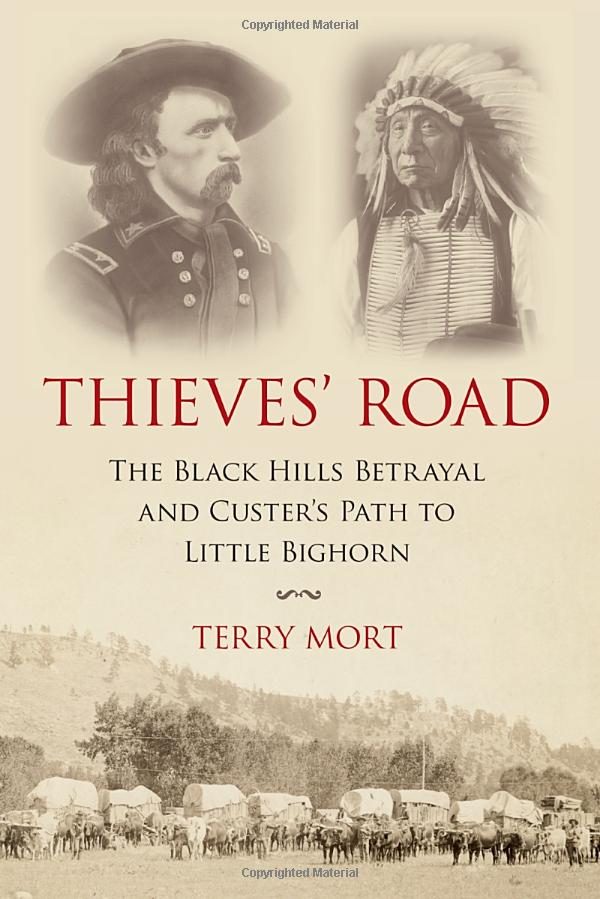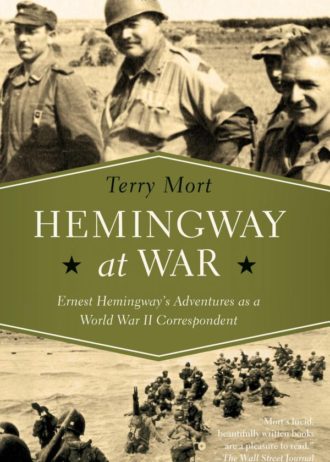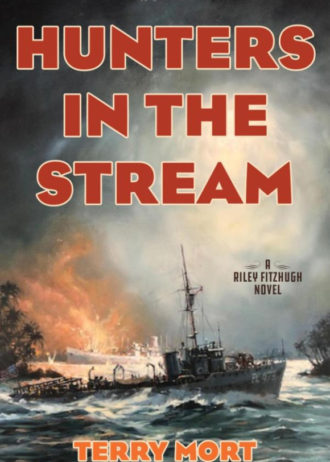Thieves’ Road: The Black Hills Betrayal and Custer’s Path to Little Bighorn
“Mort’s enlightening works about Native Americans are remarkable not only for their depth, but also the poetic beauty of his descriptions of their lives, religions and cultures…. Mort’s delightful prose will entice readers of history, geography, Native American studies and sociology. All will revel in the feeling of being in the Dakotas at the end of the 19th century.” — Starred Kirkus Review
![]() [SYNOPSIS] In the summer of 1874, Brevet Major General George Armstrong Custer led an expedition of some 1000 troops and more than one hundred wagons into the Black Hills of South Dakota. This fascinating work of narrative history tells the little-known story of this exploratory mission and reveals how it set the stage for the climactic Battle of the Little Bighorn two years later. What is the significance of this obscure foray into the Black Hills? The short answer, as the author explains, is that Custer found gold. This discovery in the context of the worst economic depression the country had yet experienced spurred a gold rush that brought hordes of white prospectors to the Sioux’s sacred grounds. The result was the trampling of an 1868 treaty that had granted the Black Hills to the Sioux and their inevitable retaliation against the white invasion. The author brings the era of the Grant administration to life, with its “peace policy” of settling the Indians on reservations, corrupt federal Indian Bureau, Gilded Age excesses, the building of the western railroads, the white settlements that followed the tracks, the Crash of 1873, mining ventures, and the clash of white and Indian cultures with diametrically opposed values. The discovery of gold in the Black Hills was the beginning of the end of Sioux territorial independence. By the end of the book it is clear why the Sioux leader Fast Bear called the trail cut by Custer to the Black Hills “thieves’ road.”
[SYNOPSIS] In the summer of 1874, Brevet Major General George Armstrong Custer led an expedition of some 1000 troops and more than one hundred wagons into the Black Hills of South Dakota. This fascinating work of narrative history tells the little-known story of this exploratory mission and reveals how it set the stage for the climactic Battle of the Little Bighorn two years later. What is the significance of this obscure foray into the Black Hills? The short answer, as the author explains, is that Custer found gold. This discovery in the context of the worst economic depression the country had yet experienced spurred a gold rush that brought hordes of white prospectors to the Sioux’s sacred grounds. The result was the trampling of an 1868 treaty that had granted the Black Hills to the Sioux and their inevitable retaliation against the white invasion. The author brings the era of the Grant administration to life, with its “peace policy” of settling the Indians on reservations, corrupt federal Indian Bureau, Gilded Age excesses, the building of the western railroads, the white settlements that followed the tracks, the Crash of 1873, mining ventures, and the clash of white and Indian cultures with diametrically opposed values. The discovery of gold in the Black Hills was the beginning of the end of Sioux territorial independence. By the end of the book it is clear why the Sioux leader Fast Bear called the trail cut by Custer to the Black Hills “thieves’ road.”
Introduction: In the summer of 1874, Brevet Major General George Armstrong Custer led some one thousand men—cavalry, infantry, civilian teamsters, and scientists—on an exploration of the Black Hills of South Dakota. The expedition consisted of ten companies of cavalry, two companies of infantry, an artillery detachment to service three Gatling guns and a threeinch- caliber rifled artillery piece. Officers included Custer’s brother Tom, as well as a number of others whose names would appear on the “killed in action” list two years later at the Little Bighorn. Youngest brother, Boston, went as a civilian guide even though he knew nothing of the country and spent most of his time wandering away and getting lost. He, too, would be killed at the Little Bighorn. Brevet Lieutenant Colonel Fred Grant, son of the president, went as an “acting aide” to Custer and an observer for General Philip Sheridan. He had apparently inherited his father’s taste for alcohol, if not his ability as a soldier. But he was a good companion, and Custer liked him. Custer also surely understood that a solid relationship with Fred made very good political sense. It wouldn’t help Custer in his subsequent entanglements and disputes with the president, but he was not to know that in 1874. The regiment would be divided into two battalions. Major George Forsyth would command one battalion; he was on loan from General Sheridan’s staff. Known as “Sandy,” Forsyth was no stranger to combat with Indians; he and fifty or so frontiersmen had held off many times their number at the Battle of Beecher’s Island, six years before. (It was not much of a battle in terms of casualties, but it was a long siege of nine days; several intrepid messengers rode for help. The arrival of the celebrated Buffalo Soldiers lifted the siege. Had they not, Forsyth, who was badly wounded, and the others could not have survived.) Custer liked Forsyth and made a point of requesting that he be made available for this assignment. Major Joseph Tilford commanded the other battalion. He was not a Custer favorite, and in fact the two disliked each other. There was rarely any middle ground between affection and the reverse in Custer’s relationships with other officers. Tilford was not particularly enthusiastic about the assignment. He was stationed at Fort Rice in command of the Seventh Cavalry’s several companies there and would just as soon have stayed in garrison enjoying whatever comforts that post might offer. But there was no alternative to Tilford just then, and so Custer ordered him to go. Major Marcus Reno, who would go on to controversy and notoriety at the Little Bighorn, was on detached service doing surveying work along the Canadian border. The regimental band went along, as did a collection of seventy-five or so Arikara and Santee scouts, including Custer’s favorite, Bloody Knife. Also along as a guide was “Lonesome” Charley Reynolds, so called because of his natural diffidence—or his atypical behavior in a line of work usually featuring colorful characters full of tall tales and braggadocio. But Reynolds did not lack courage, and he would have an important role in the expedition and an equally important influence on the events that followed. He, too, would die at the Little Bighorn, along with Bloody Knife. Custer also invited five newspapermen. The General was keenly aware of the value of publicity, and these journalists would play an important role by obliging him. One of the reporters, Samuel Barrows, wrote for the New York Tribune. Barrows had been along on Custer’s 1873 Yellowstone River expedition that surveyed the valley for the Northern Pacific Railroad. Barrows had dispatched colorful and laudatory accounts of Custer’s battles with the Sioux along the Yellowstone. Another reporter, William Curtis, worked for the Chicago Inter Ocean and the New York World. Curtis had not known Custer before this time, but he soon fell under the sway of the general’s personality—Custer could be charming when it suited him. And Curtis’s reports would significantly influence subsequent events. A third journalist, William Knappen, worked for the Bismarck Tribune. His attitudes toward the expedition and the Indian situation accurately reflected majority western opinion that was impatient or, more accurately, furious with the handling of Indians in general and the Black Hills in particular. The other two reporters were from St. Paul papers. St. Paul was vitally interested in the Seventh Cavalry, since the commanding officer of the regiment was stationed there, as was the commander of the Dakota Department, General Alfred Terry. Civilian scientists also were part of the expedition. Their assignment was to assess the geology and flora and fauna. A photographer was there to record events. The chief engineer, Brevet Lt. Colonel William Ludlow, and his assistants would map the region. Civilians managed the supply train that consisted of one hundred and ten wagons. And there were two civilian “practical miners”—so named by the newspapers and rosters to distinguish them from the scientific corps. The expedition left from Fort Abraham Lincoln near Bismarck, a rough-hewn town on the upper Missouri River, and the western terminus of the Northern Pacific Railroad. They would be gone two months: July and August. The troops and their civilians would travel some three hundred miles southwest across the Plains and Badlands before reaching the Black Hills, which by the time they arrived seemed like an oasis, as indeed they were, of a kind. Given the size of Custer’s force (larger even than the one he took to the Little Bighorn), he felt he could handle anything that came along. But he knew he was going into potentially hostile territory. (In a letter to Terry he said: “I am confident the Indians do not intend to strew flowers on our pathway.”) And he knew he might very well be outnumbered if it came to a fight. Trying to understand the odds before he left, Custer communicated with a regional Indian Agent who told him the best estimate of Sioux and Northern Cheyenne in the different agencies of the North Platte and Missouri was more than three thousand warriors, most of whom were armed with “one or more pistols, exclusive of other arms. All have bows and arrows. About one-half of the warriors remaining at the agencies have repeating rifles, all others breechloaders. I have known Indians at the White River Agency to have as many as 3000 rounds of ammunition for a single gun . . . fully three fourths of all enumerated are hostile.” Apparently, Custer might need all the men he had and, perhaps, then some. The stated objective of the expedition was to explore the area and find a location for a permanent military installation—a fort. The proposed fort was a response to Sioux and Cheyenne attacks on the settlements to the south—settlements below the boundary of the Sioux reservation (essentially the southern border of South Dakota). The army needed a post near the Nebraska border to interdict, or discourage, warriors heading from the reservations to the southern settlements and travel routes. As General Sheridan put it: “by holding an interior point in the heart of the Indian country we could threaten the villages and stock of the Indians, if they made raids on our settlements.” Custer had another objective, however, one that was unstated (and even officially disavowed) by the army but well understood by the civilians (and troops)—both those on the expedition and those watching and cheering the effort. That was to determine whether there was gold in the Black Hills. For decades there had been rumors and stories about potentially rich gold deposits in the Hills, but no one knew whether those stories were true—or, more accurately, whether there was enough gold to justify the risks of looking for it. The remoteness and inaccessibility of the Hills coupled with Sioux enmity had been historical barriers to thorough investigation. But Custer’s expedition was probably strong enough to deal with any war parties, and his practical miners were there to determine whether the rumors of gold had some basis in fact. Though this objective was kept sub rosa, there is no doubt that Custer was intent on making the discovery, if there was anything to discover. As Lieutenant James Calhoun, Custer’s adjutant and brother-in-law wrote: “The Commanding Officer of the Expedition has expressed a desire on many occasions to explore the Black Hills, believing that it would open a rich vein of wealth calculated to increase the commercial prosperity of this country. Having this object in view, he made known his impressions through the recognized military channels—which were favorably received.” The “which” in this case of course refers to Custer’s recommendations, not those of the military channels. So it’s fair to wonder whether the idea for the expedition originated with Custer or Sheridan. Given their close personal relationship it’s likely that they were of the same mind about the expedition’s goals, stated and otherwise. Two birds with one stone. There was some difficulty about the whole project, though—the Black Hills were part of the Sioux reservation, granted by the 1868 Treaty of Fort Laramie. Under the treaty, no whites other than “officers, agents and employees of the government” assigned to, or servicing, various agencies were permitted to enter the reservation. In fact, the army was responsible for intercepting or evicting any civilian individuals or outfits that entered the Hills or any part of the reservation. And in the period after the 1868 treaty until Custer’s expedition (and even afterward), the army did just that. As General Terry warned in a letter to the Sioux City Times, any enterprise heading for the Black Hills would be illegal and “the consummation of which it will be my duty, under the law, and my instructions to prevent by the use, if necessary, of the troops at my disposal.” The very idea that US troops would use force to prevent US citizens from exploring useful land, given away to hostile Indians, raised more than a few hackles among western politicians and editorialists—to say nothing of regular citizens. Nor did the army have much sympathy for this assignment. But they did it. Note that the army prevented white settlers from going into the Black Hills even before the treaty. In 1867 General William T. Sherman wrote to Terry: “I agree with you perfectly that we are not in a position to permit an invasion of that region, for no sooner would a settlement be inaugurated than an appeal would come for protection. . . . You may therefore forbid all white people going there at present and warn all who go in spite of your prohibition, that the United States will not protect them now, or until public notice is given that the Indian title is extinguished.”8 Sherman was simultaneously worried that the “invasion” would stir up the Sioux and that his limited resources would be stretched by a called-for additional post. Note, too, that Sherman refers to the Indians’ “title” to the land, and this was before the treaty legalized that title. Custer also took a hand in the business when a group of fifty civil- ians from Bismarck organized to explore the Black Hills for gold. Their leader, said Custer, was “the keeper of a disreputable house opposite this post.” Custer went on to say: “From the irresponsible character of the leader, and many men who are likely to form the party, no good results are to be expected from this projection. While great harm and embarrassment to our relations with the Indians is almost sure to follow.” Custer had a notice posted in the Bismarck Tribune warning the locals that he would use troops to prevent the expedition. The citizens of Bismarck were a rough crowd, mostly. As Custer’s wife, Elizabeth (Libby), said: “[They were men] whose lawless life as gamblers and murderers had so outraged the sentiments of the few law-abiding residents that they had forced them to depart.” No doubt Custer knew that not only would that expedition violate the treaty, but that these kinds of men were more than likely to make trouble with the Sioux. On the other hand, the same treaty restrictions did not apparently apply to the army’s ability to penetrate the Hills. The army determined that, as representatives or employees of the federal government, they were authorized to go where civilians were excluded—under the somewhat ambiguous terms of the 1868 treaty. As temporary employees of the army, the civilian members of the expedition were also legal, although the usual distinction between the letter of the law and the spirit certainly applied to these civilians, to say nothing of the reporters who were certainly not federal employees. There were perhaps enough fig leaves to cover this expedition, but only just. National and international economics and politics were some of the driving forces behind Custer’s expedition—to the extent that looking for gold was an unspoken objective. The United States and most of Europe were in the grips of a terrible economic depression. The economies of these countries had recently become intertwined through a combination of trade and international finance. (Odd as it may seem, it is possible to trace the connections between the 1873 collapse of the Russian wheat market and Custer’s mission—as will be described later.) If Custer could find gold in the Black Hills, there would be a significant and positive ripple effect throughout the sagging US economy. But as importantly, the US Treasury was still trying to dig out from under the mountain of debt incurred during the Civil War—debt that was denominated in gold and would therefore have to be repaid in gold. In short, gold mattered to more than just the rough-and-ready prospectors who found it. They would sell it, one way or another, through the banking system, and the gold would be bought by the Treasury, monetized, and then used to pay federal debts. The availability— and possibility—of gold therefore affected national political and economic decisions. Consequently, the Black Hills Expedition was more important than just a reconnaissance in force, and there was more to be looked for than just a site for a fort. There were also reports that the Hills contained other valuable resources, beyond the gold. The land was said to be ideal for agriculture, ranching, and timbering. It was well watered and wooded, with broad meadows for grazing or farming. Game animals were plentiful. As a result of these circulating stories, the Hills were a source of continuing and violent frustration among white westerners, who were enduring the difficulties of the depression, like their cousins in the east. Plains farmers whose crops were devastated by hordes of grasshoppers thought longingly of the reported fertility of the Hills. Town builders on the treeless Plains thought with equal longing of the vast timber resources. That such a magnificent combination of natural resources should lie undeveloped and unused, except by the occasional Sioux hunting party, outraged the western settlers. As the Yankton Press & Dakotaian editorialized: This abominable compact [the 1868 Fort Laramie Treaty] with the marauding bands that regularly make war on the whites in the summer and live on government bounty all winter, is now pleaded as a barrier to the improvement and development of one of the richest and most fertile sections in America. What shall be done with these Indian dogs in a manger? They will not dig the gold or let others do it. . . . They are too lazy and too much like mere animals to cultivate the fertile soil, mine the coal, develop the salt mines, bore the petroleum wells, or wash the gold. Having all these things in their hands, they prefer to live as paupers, thieves and beggars; fighting, torturing, hunting, gorging, yelling and dancing all night to the beating of old tin kettles. The “old tin kettles” reference is a nice bit of condescension. But you could hardly find a more succinct expression of western attitudes toward the Indians in general and the 1868 Treaty of Fort Laramie in particular. Besides, not all the hostile bands had signed the treaty. Sitting Bull and his followers had ignored it and had stuck to their traditional way of life, which meant hunting, wandering, and occasionally raiding. Other bands agreed and settled on reservations, but that did not stop raiding. For many warriors the reservation was a convenient sanctuary and, in times of need, a source of rations. The treaty was a weir, not a dam, in the river of violence; it caused a slight pause, but there was more to come downstream. Since so few westerners had actually seen the Black Hills or their reputed riches, the stories told by a few mountain men who had been there gathered mythic status over the years. The Hills were a jewel in an Ethiope’s ear, and the problem was how to disengage the ear from the Ethiope. Or, to change the metaphor, westerners felt themselves to be collectively a current-day Tantalus, but a Tantalus who was being punished not by the gods but by detested eastern bureaucrats—and self-appointed humanitarians and parsons—policy makers who understood neither economics nor the difficulties and dangers endured by the western settlers. Let those eastern Pecksniffs spend a night on the Plains, where there was no help for miles and the darkness went on forever, and let them listen to the howls of wolves and wonder whether the wolves walked on four legs or two. Let them understand the terror of the night and afterward view the hideous mutilation of Indian victims—and then let them come and deliver their sermons and wave their treaties. Philanthropy had a way of evaporating the closer one came to the tribes—although, in fairness, a handful of dedicated missionaries lived among the tribes and tried to spread their message of peace. But for most pioneer settlers, the West was red in tooth and claw. That was the truth of it, as far as they experienced it. And in the years immediately after the Civil War, they were not far wrong. In exchange for enduring those dangers, the settlers wanted opportunity. That’s why they had come to this remote and dangerous place. And the Black Hills were the most glittering of opportunities, so they believed. There hung the fruit, all the more tantalizing for being viewed through the prism of imagination and rumor. But standing in the way were ignorant or asinine eastern preachers and politicians—and a treaty that was nothing more than a piece of paper signed by bureaucrats and agreed to by illiter- ates who had little, if any, intention of abiding by the terms. So said the westerners, if not unanimously, then close to it. In short, the western press and population hated the treaty and warmly endorsed Custer’s expedition. They saw it for what it was—the thin edge of the wedge. To say that looking for gold (and other resources) was an unpublicized objective is not to suggest that the stated military objective was a fiction to cover a gold-hunting expedition. On the contrary, the military and economic objectives were, in this case, perfectly congruent. That congruency was typical of this period in which the federal government and private enterprise cooperated closely on a number of projects deemed to be in the national interest. If people managed to get rich in the process, so much the better. Further, the army’s role in settling the west went well beyond battles with native tribes. It involved mapping and collecting scientific information about the largely unknown territories. Officers who had been trained at West Point—especially those who did well academically—were primarily engineers, surveyors, and scientists, since that was the primary focus of the Academy’s curriculum. The best performers were well prepared for scientific and topographical missions. Militarily, the story was slightly different. Officers were trained in the traditional Napoleonic tactics: artillery preparation followed by a massed bayonet charge with cavalry waiting to exploit defensive gaps or lapses, or to block enemy maneuvers. The carnage of the Civil War was to a very real extent the result of the Academy’s tactical curriculum, which was hardly different from those of the European academies. The Academy prepared the professionals for war between nation-states, and although the tactics were wasteful and suicidal, the officers at least could tell themselves they were following the rules. Unfortunately, the Academy graduates were totally unprepared for the task of finding and fighting Indians. That subject was considered a waste of time at the Point. As a result, there were no rules to follow. But the key point is that Custer’s expedition was by no means unique or unusual in combining military and scientific/geographic objectives. The army did not see them as separate missions. If you were going to fight over a ground, you needed to know what it looked like. And if your country had acquired vast new territory—even if it was uninhabited and uncontested— it was your job to map it and discover any indications of natural resources. As an example, the five initial surveys of potential transcontinental roads (initially stagecoach and ultimately railroad) were conducted before the Civil War by junior officers of the army. And well conducted, too. Finally, most of the West was federal territory. Who but the army was available to survey and evaluate it? Until Custer’s expedition, the Black Hills were mostly terra incognita, as far as white settlers and the army were concerned. The Hills are a mysterious island rising from the Plains. They appear from the Plains to be a citadel with no access points. And it is a mighty citadel, at that; they cover more than forty-five hundred square miles and sit along the border between southeastern South Dakota and Wyoming. The very inaccessibility of the Black Hills raises questions about whether the interior of the Hills would be a good location for a fort. Supplies would be a problem; there were no navigable rivers close by. The Hills were cut by deep ravines and rivers and streams and were guarded by escarpment, so that although the environment would be healthful by comparison to forts on the Plains or along rivers, the fort would be a difficult place from which to observe and maneuver. A fort there might be nothing more than an island in an island. The difficulty of finding access into the Hills had been one of the barriers to exploration, especially to white civilians and soldiers who depended on wagon trains for supplies. Further, a fort in the Hills exposed the troops to increased risk of attack. As Lt. Calhoun said during the march to the Hills: “The prevailing impression is that the Indians will not attack us until we get into the interior of the Black Hills, when they will have a decided advantage over us. Bushwhacking with unseen enemies is a game of warfare not to be desired.” Bushwhacking with unseen enemies was not a subject taught at West Point, nor was it the kind of thing the army was good at. In fact, the army never did build a fort in the Hills proper. It wouldn’t be until 1878 when Fort Meade was built next to Bear Butte on the northeastern edge of the Hills. That was in response to cries for protection from the mining towns that had sprung up after Custer’s expedition. So it’s fair to wonder which expedition objective really had the highest priority. On the other hand, Custer’s thorough scout through the interior of the Hills may have convinced him that the Hills, beautiful as they were, were not a good site for a fort and led ultimately to the Bear Butte location. Over the previous decades some intrepid explorers and prospectors had penetrated the Hills, but they had been driven out or killed by the Sioux, who had earlier driven the Kiowa, Cheyenne, and Crow tribes from this territory. But in the days before the Sioux were feeling overwhelmed by white civilization, they were not so unfriendly. Indeed, in 1846 the youthful historian Francis Parkman joined a band of Oglala Sioux on a brief expedition into the Black Hills to cut lodge poles. He describes the inaccessible nature of the Hills: “[No] white man with us had ever seen the difficult and obscure defiles though which the Indians intended to make their way. I passed them afterwards and had much ado to force my distressed horse along the narrow ravines and through chasms where daylight could scarcely penetrate.” One of Parkman’s companions, a “vagrant Indian trader” named Reynal, spoke of the gold in the Hills: “Many a time when I have been with the Indians, I have been hunting for gold all through the Black Hills. There’s plenty of it here; you may be certain about that.” But Reynal went on to say, “It won’t do for a white man to be rummaging too much about these mountains. . . . I believe myself that it’s no good luck to be hunting about here after gold.” Reynal was typical of the type of men who spread stories about gold; he no doubt hoped that being married to an Oglala woman offered him some protection. Parkman’s book, The Oregon Trail, was published in 1849—a year that was significant in the story of gold. In the 1850s there were two army expeditions, but both of these merely skirted the outer edges of the Hills, and one, led by Lt. Gouverneur Warren, was turned away by the Sioux. (Warren went on to become one of the heroes at Gettysburg, the man who recognized that Little Round Top was undefended and moved troops there just in time.) Another source of stories about gold was the peripatetic Jesuit missionary, Father Pierre-Jean De Smet. He was generally respected, and his accounts could hardly be dismissed, although General Sheridan described him as spreading “dreamy stories.” Still, De Smet was no garrulous mountain man whose stories might be discounted as the usual tall tales. More than one westerner said to himself that there must be something to it. The Sioux had a particular regard for the Hills as a hunting ground and, for some, as a sacred place. Indeed, Francis Parkman called the Hills “a hunter’s paradise.” When the buffalo in their mysterious ways made themselves scarce, the Sioux could retire to the Black Hills where elk, deer, and antelope were plentiful. Indeed, the Sioux called the Hills their “meat pack.” (In fact, the Sioux preferred deer to buffalo for flavor and for the softness of its skin, but of course the buffalo herds were vast and provided almost everything the Sioux required—food, clothing, utensils, lodge coverings, sinews for rope, even glue.) As far as the Sioux were concerned, the Black Hills belonged to them, originally—and most legitimately to the Sioux—by right of conquest, and more recently under the 1868 Treaty of Fort Laramie, in which the whites granted to the Sioux something, in their eyes, they already owned. If the white man wanted to put something on a sheet of paper, well, that was no substitute for grim and obvious reality, for the unwritten laws of war. But if the treaty meant a cessation in the troubles, then fair enough. And if it could keep greedy miners and frontiersmen out of the Hills, so much the better. Like other native tribes anywhere, the Sioux dreaded the discovery of precious metals in their territory. They knew a gold strike would release a torrent of white miners. And what had been a pristine wilderness, rich in game animals, would be degraded by miners grubbing around in the placers and sluice boxes and returning at night to wretched muddy mining camps offering gambling, whiskey, and loose women. To the Sioux this would be a tragedy of multiple dimensions—economic, aesthetic, environmental, and spiritual. It was unthinkable. Black Moon, a Hunkpapa Sioux, reportedly said that any Indian who showed the gold fields to white men should die. But the rumors would not die. Lt. Calhoun wrote: “I have read in a newspaper of an Indian squaw going into one of our forts some years ago (I believe it was Fort Laramie) and offering to barter or sell a lump of gold about the size of an egg, which she said was obtained from the Black Hills.” Without the help of any Sioux informers, however, Custer’s expedition did find gold. There were no egg-sized nuggets, and it was not a bonanza. But it was enough. It was the news the westerners wanted to hear. It was the political and economic leverage they needed. And from the moment of Custer’s first reports of the discovery, Sioux ownership of the Black Hills was doomed, just as they feared it would be—but not before a fight, for Custer’s expedition was also a significant cause of stirring up, or reigniting, the hostilities of all the Sioux tribes, hostility that resulted in the battle at the Little Bighorn two years later. It was said that George Custer dug his grave—and, as importantly, the graves of 262 men—when he led an expedition into the Black Hills of South Dakota in the summer of 1874. Is that true? And if so, how did it all come about?
ISBN: 9781616149604
Publisher: Prometheus
Hardcover | e-Book
340 pages












